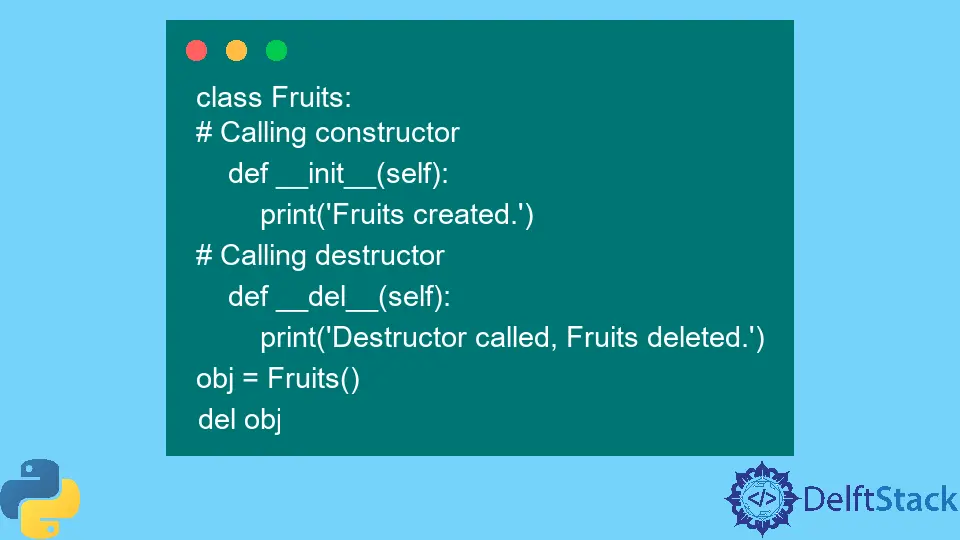Python Destructor
- What is a Destructor in Python?
- How to Implement a Destructor in Python
- Best Practices for Using Destructors
- Conclusion
- FAQ

Python is a powerful programming language that offers various features to manage memory and resources efficiently. One such feature is the destructor, which plays a crucial role in object lifecycle management.
In this tutorial, we will delve into what a destructor is, how it functions in Python, and when to use it effectively. Whether you’re a beginner looking to grasp the basics or an experienced developer seeking to refine your skills, understanding destructors can enhance your programming toolkit. So, let’s dive into the world of Python destructors and discover how they can help streamline your code and resource management.
What is a Destructor in Python?
A destructor in Python is a special method called when an object is about to be destroyed. It allows developers to define cleanup actions that should occur before an object is removed from memory. In Python, the destructor is defined using the __del__ method. This method is automatically invoked when the reference count of an object drops to zero, indicating that the object is no longer in use.
The primary purpose of a destructor is to free up resources that the object may have acquired during its lifetime. This includes closing files, releasing network connections, or deallocating memory. Although Python has a built-in garbage collector that automatically handles memory management, using destructors can help ensure that resources are properly released, especially when dealing with external resources.
Here’s a simple example demonstrating a destructor in action:
class Resource:
def __init__(self):
print("Resource acquired.")
def __del__(self):
print("Resource released.")
obj = Resource()
del obj
Output:
Resource acquired.
Resource released.
In this example, when the Resource object is created, the __init__ method is called, indicating that a resource has been acquired. When the object is deleted using the del statement, the __del__ method is invoked, signaling that the resource has been released. This illustrates how destructors can manage resource cleanup effectively.
How to Implement a Destructor in Python
Implementing a destructor in Python is straightforward. You simply define the __del__ method within your class. Here’s a step-by-step breakdown:
- Define the Class: Start by creating a class that represents the object you want to manage.
- Implement the
__del__Method: Within the class, define the__del__method to specify the cleanup actions that should take place when the object is destroyed. - Create an Instance: Instantiate the class to create an object.
- Delete the Object: Use the
delstatement to delete the object, which will trigger the destructor.
Let’s look at a more detailed example that includes resource management:
class DatabaseConnection:
def __init__(self):
self.connection = self.connect_to_database()
print("Database connection established.")
def connect_to_database(self):
return "Connected to the database"
def __del__(self):
self.close_connection()
print("Database connection closed.")
def close_connection(self):
print("Cleaning up resources...")
db = DatabaseConnection()
del db
Output:
Database connection established.
Cleaning up resources...
Database connection closed.
In this example, the DatabaseConnection class simulates a database connection. Upon instantiation, a connection is established, and when the object is deleted, the __del__ method is called. This method invokes the close_connection method to clean up resources, demonstrating how destructors can handle resource management effectively.
Best Practices for Using Destructors
While destructors can be beneficial, there are several best practices to keep in mind to ensure they are used effectively:
-
Avoid Circular References: Python uses reference counting for memory management. Circular references can prevent destructors from being called, leading to memory leaks. To avoid this, ensure that objects do not reference each other in a way that creates a cycle.
-
Use with Caution: Destructors can introduce complexity to your code. Use them only when necessary, especially for resource management. In many cases, relying on context managers and the
withstatement is a better approach. -
Keep it Simple: The
__del__method should perform simple and quick tasks. Avoid complex logic that could lead to exceptions, as exceptions raised in destructors are ignored, which can make debugging difficult.
- Test Thoroughly: Always test your classes with destructors to ensure they behave as expected. Check that resources are released appropriately and that there are no memory leaks.
Here’s an example of a class that adheres to these best practices:
class FileHandler:
def __init__(self, filename):
self.file = open(filename, 'w')
print(f"File {filename} opened.")
def __del__(self):
self.file.close()
print("File closed.")
file_handler = FileHandler('example.txt')
del file_handler
Output:
File example.txt opened.
File closed.
In this example, the FileHandler class opens a file upon instantiation. The destructor ensures that the file is closed when the object is deleted. This shows how destructors can effectively manage file resources while adhering to best practices.
Conclusion
Understanding Python destructors is essential for effective resource management in your applications. By implementing the __del__ method, you can ensure that resources are properly released when objects are no longer in use. While destructors can be powerful, it’s important to use them judiciously and follow best practices to avoid potential pitfalls. Whether you’re managing database connections, file handlers, or other resources, mastering destructors will enhance your programming skills and improve the efficiency of your code.
FAQ
-
What is the purpose of a destructor in Python?
A destructor is used to define cleanup actions that should occur before an object is destroyed, helping manage resources effectively. -
How do you define a destructor in Python?
You define a destructor using the__del__method within your class.
-
When is a destructor called in Python?
A destructor is called automatically when the reference count of an object drops to zero. -
Can you rely solely on destructors for resource management in Python?
While destructors can help, it’s often better to use context managers and thewithstatement for managing resources. -
What happens if there are circular references in Python?
Circular references can prevent destructors from being called, potentially leading to memory leaks.
Vaibhhav is an IT professional who has a strong-hold in Python programming and various projects under his belt. He has an eagerness to discover new things and is a quick learner.
LinkedIn